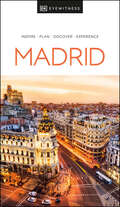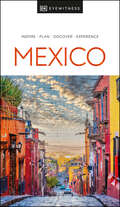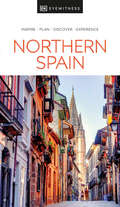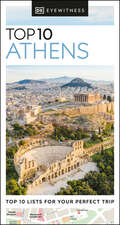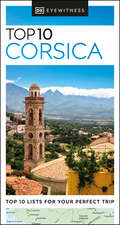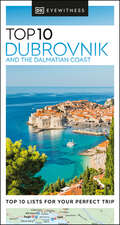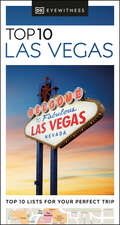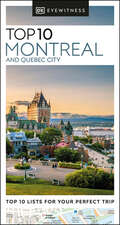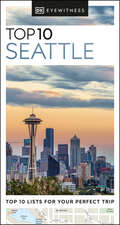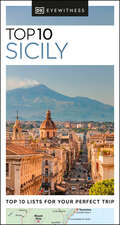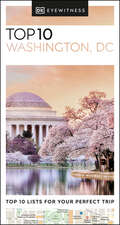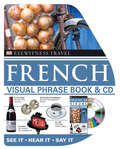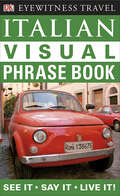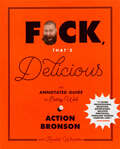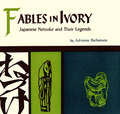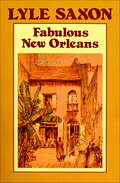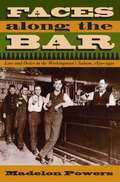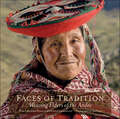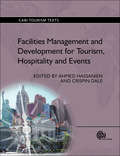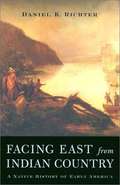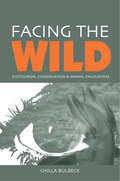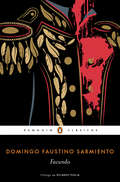- Table View
- List View
Eyewitness Madrid (Travel Guide)
by DK EyewitnessWith its historic plazas, glorious gardens and regal architecture, Madrid dazzles with opulence. But for all its trappings of royalty, this intimate city is also a creative powerhouse, home to world-class art galleries, bustling markets and musical spectacles.Whether you want to visit royal palaces, indulge at atmospheric tapas bars or dance into the early morning, your DK Eyewitness travel guide makes sure you experience all that Madrid has to offer.Our updated guide brings Madrid to life, transporting you there like no other travel guide does with expert-led insights, trusted travel advice, detailed breakdowns of all the must-see sights, photographs on practically every page, and our hand-drawn illustrations which place you inside the city's iconic buildings and neighborhoods. We&’ve also worked hard to make sure our information is as up-to-date as possible following the COVID-19 outbreak. DK Eyewitness Madrid is your ticket to the trip of a lifetime. Inside DK Eyewitness Madrid you will find: A fully-illustrated top experiences guide: our expert pick Madrid&’s must-sees and hidden gemsAccessible itineraries to make the most out of each and every dayExpert advice: honest recommendations for getting around safely, when to visit each sight, what to do before you visit, and how to save time and moneyColor-coded chapters to every part of Madrid, from central neighbourhoods to areas beyond the capitalPractical tips: the best places to eat, drink, shop and stayDetailed maps and walks to help you navigate the state easily and confidently Covers: West Madrid, East Madrid, Malasana, Chueca and Salamanca, Beyond The Centre, Day Trips from Madrid Planning on touring the country? Don&’t forget to check out DK Eyewitness Spain. Or if you want the best of Madrid in your pocket, try our DK Eyewitness Top 10 Madrid.About DK Eyewitness: At DK Eyewitness, we believe in the power of discovery. We make it easy for you to explore your dream destinations. DK Eyewitness travel guides have been helping travellers to make the most of their breaks since 1993. DK Eyewitness travel guides have been helping travelers to make the most of their breaks since 1993.Filled with expert advice, striking photography and detailed illustrations, our highly visual DK Eyewitness guides will get you closer to your next adventure. We publish guides to more than 200 destinations, from pocket-sized city guides to comprehensive country guides. Named Top Guidebook Series at the 2020 Wanderlust Reader Travel Awards, we know that wherever you go next, your DK Eyewitness travel guides are the perfect companion.
Eyewitness Mexico (Travel Guide)
by DK EyewitnessMany are drawn to Mexico for its pristine beaches, but exploring inland reveals a treasure trove of natural wonders, from vast canyons to snow-capped volcanoes. And when it comes to urban pleasures, few places in the world can match Mexico city, with its teeming markets, vibrant galleries and exuberant festivals.Whether you want to sample smoky mezcal in Oaxaca, swim in the Yucatán's crystal-clear cenotes or discover ancient Maya ruins in the jungle, your DK Eyewitness travel guide makes sure you experience all that Mexico has to offer. Our updated guide brings Mexico to life, transporting you there like no other travel guide does with expert-led insights, trusted travel advice, detailed breakdowns of all the must-see sights, photographs on practically every page, and our hand-drawn illustrations which place you inside the country's iconic buildings and neighborhoods. We&’ve also worked hard to make sure our information is as up-to-date as possible following the COVID-19 outbreak. DK Eyewitness Mexico is your ticket to the trip of a lifetime. Inside DK Eyewitness Mexico you will find: - A fully-illustrated top experiences guide: our expert pick Mexico&’s must-sees and hidden gems- Accessible itineraries to make the most out of each and every day- Expert advice: honest recommendations for getting around safely, when to visit each sight, what to do before you visit, and how to save time and money- Color-coded chapters to every part of Mexico, from Baja California to Southern Mexico, Mexico City to the Gulf Coast - Practical tips: the best places to eat, drink, shop and stay- Detailed maps and walks to help you navigate the country easily and confidently- Covers: Mexico City, Around Mexico City, Northern Mexico, The Colonial Heartland, Southern Mexico, The Gulf Coast, The Yucatan PeninsulaWant the best of Cancún and the Yucatán in your pocket? Don&’t forget to check out DK Eyewitness Top 10 Cancún and the Yucatán.About DK Eyewitness: At DK Eyewitness, we believe in the power of discovery. We make it easy for you to explore your dream destinations. DK Eyewitness travel guides have been helping travellers to make the most of their breaks since 1993. Filled with expert advice, striking photography and detailed illustrations, our highly visual DK Eyewitness guides will get you closer to your next adventure. We publish guides to more than 200 destinations, from pocket-sized city guides to comprehensive country guides. Named Top Guidebook Series at the 2020 Wanderlust Reader Travel Awards, we know that wherever you go next, your DK Eyewitness travel guides are the perfect companion.
Eyewitness Northern Spain (Travel Guide)
by DK EyewitnessExplore wild mountain terrain, vibrant cities and romantic coastline. Whether you want to trek the dramatic peaks of the Picos de Europa, appreciate contemporary art at Museo Guggenheim or hop from bar to bar in the side streets of San Sebastian, your DK Eyewitness travel guide makes sure you experience all that Northern Spain has to offer.Our updated guide brings Northern Spain to life, transporting you there like no other travel guide does with expert-led insights, trusted travel advice, detailed breakdowns of all the must-see sights, photographs on practically every page, and our hand-drawn illustrations which place you inside the region&’s iconic buildings and neighborhoods. We&’ve also worked hard to make sure our information is as up-to-date as possible following the COVID-19 outbreak. DK Eyewitness Northern Spain is your ticket to the trip of a lifetime. Inside DK Eyewitness Northern Spain you will find: - A fully-illustrated top experiences guide: our expert pick Northern Spain&’s must-sees and hidden gems- Accessible itineraries to make the most out of each and every day- Expert advice: honest recommendations for getting around safely, when to visit each sight, what to do before you visit, and how to save time and money- Color-coded chapters to every part of Northern Spain, from Galicia to the Basque Country, Navarra to Northern Castilla - Practical tips: the best places to eat, drink, shop and stay- Detailed maps and walks to help you navigate the region country easily and confidently - Covers: Galicia, Asturias and Cantabria, Northern Castilla and Leon, The Basque Country, Navarra and La Rioja, Central and Eastern Pyrenees Planning on touring the country? Don&’t forget to check out DK Eyewitness Spain.About DK Eyewitness: At DK Eyewitness, we believe in the power of discovery. We make it easy for you to explore your dream destinations. DK Eyewitness travel guides have been helping travellers to make the most of their breaks since 1993. Filled with expert advice, striking photography and detailed illustrations, our highly visual DK Eyewitness guides will get you closer to your next adventure. We publish guides to more than 200 destinations, from pocket-sized city guides to comprehensive country guides. Named Top Guidebook Series at the 2020 Wanderlust Reader Travel Awards, we know that wherever you go next, your DK Eyewitness travel guides are the perfect companion.
Eyewitness Top 10 Athens (Pocket Travel Guide)
by DK EyewitnessHome to ancient temples, world-class museums and an exhilarating cultural scene, Greece&’s dynamic and vibrant capital brings together the best of ancient and contemporary Greece.Make the most of your trip to this exhilarating city with DK Eyewitness Top 10 Athens. Planning is a breeze with our simple lists of ten, covering the very best that Athens has to offer and ensuring that you don&’t miss a thing. Best of all, the pocket-friendly format is light and easily portable; the perfect companion while out and about. DK Eyewitness Top 10 Athens is your ticket to the trip of a lifetime. Inside DK Eyewitness Top 10 Athens you will find: - Detailed Top 10 lists of Athens&’ must-sees including the Acropolis, the National Archaeological Museum, the Museum of Cycladic Art and the Temple of Olympian Zeus.- Easy-to-follow itineraries including ideas for day trips, weekends and a week&’s worth of plans to make the most out of each and every day- Expert advice: honest recommendations on Athen&’s most interesting areas, with the best places for shopping, eating out and sightseeing, with top tips on getting ready, getting around and staying safe- Themed lists including the best city strolls, nearby islands, museums, local dishes and much more- Detailed maps including a laminated pull-out map of Athens, plus eight full-colour area maps- Covers: Athens Highlights, Acropolis, The Agora, National Archaeological Museum, Museum of Cycladic Art, Roman Forum and Tower of the Winds, Benaki Museum, Kerameikos, Byzantine and Christian Museum, Philopappos Hill, Temple of Olympian Zeus, Moments in History, Moments in the History of Theatre and Music Archaeological Sites, Churches, Museums, Philosophers and Writers, Athenian Legends, Greek Inventions Artistic Styles, City Strolls, Off the Beaten Track, Greek Dishes, Restaurants, Places to Shop, Athens for Free, Festivals and Events,Plaka, Makrygianni and Koukaki, Monastiraki, Psyrri, Gazi and Thisio, Omonia and Exàrhia, Syndagma and Kolonaki, Piraeus, North to Delphi, Into the Peloponnese, Around the Attica CoastLooking for more on Greece&’s culture, history and attractions? Don&’t forget to check out DK Eyewitness Greece: Athens and the Mainland. Island hopping? Try our DK Eyewitness Greek Islands.About DK Eyewitness: At DK Eyewitness, we believe in the power of discovery. We make it easy for you to explore your dream destinations. DK Eyewitness travel guides have been helping travellers to make the most of their breaks since 1993. Filled with expert advice, striking photography and detailed illustrations, our highly visual DK Eyewitness guides will get you closer to your next adventure. We publish guides to more than 200 destinations, from pocket-sized city guides to comprehensive country guides. Named Top Guidebook Series at the 2020 Wanderlust Reader Travel Awards, we know that wherever you go next, your DK Eyewitness travel guides are the perfect companion.
Eyewitness Top 10 Corsica (Pocket Travel Guide)
by DK EyewitnessAn enigmatic island of towering mountains, timeless villages and chic seaside resorts, Corsica more than lives up to its moniker of the &“Island of Beauty&”.Make the most of your trip to this Mediterranean paradise with DK Eyewitness Top 10. Planning is a breeze with our simple lists of ten, covering the very best that Corsica has to offer and ensuring that you don&’t miss a thing. Best of all, the pocket-friendly format is light and easily portable; the perfect companion while out and about. DK Eyewitness Top 10 Corsica is your ticket to the trip of a lifetime. Inside DK Eyewitness Top 10 Corsica you will find: - Detailed Top 10 lists of Corsica&’s must-sees including Ajaccio, Bonifacio, Bastia, Calvi and more- Easy-to-follow itineraries including ideas for day trips, weekends and a week&’s worth of plans to make the most out of each and every day- Expert advice: honest recommendations on Corsica&’s most interesting areas, with the best places for shopping, eating out and sightseeing, with top tips on getting ready, getting around and staying safe- Themed lists including the best beaches, pretty villages, wild swims, wineries and much more- Detailed maps including a laminated pull-out map of Corsica, plus four full-colour area maps- Covers: Corsica Highlights, Ajaccio, Golfe de Valinco, Le Sartenais, Bonifacio, Bastia, Cap Corse, St-Florent and the Nebbio, Calvi, Corte and its Hinterland, Golfe de Porto, Moments in History, Prehistoric Sites, Churches and Cathedrals, Pretty Villages, Watchtowers and Lighthouses, Natural Wonders, Great Beaches, Boat Trips, Outdoor Activities, Treks and Walks, Corsican Wildlife, Wild Swims, Children&’s Attractions; Culinary Specialities; Restaurants; Wineries; Festivals Music Festivals;Ajaccio and the West Coast; Bonifacio and the South Corte, the Interior and the East Coast; Bastia and the NorthLooking for more on France&’s culture, history and attractions? Don&’t forget to check out our DK Eyewitness France.About DK Eyewitness: At DK Eyewitness, we believe in the power of discovery. We make it easy for you to explore your dream destinations. DK Eyewitness travel guides have been helping travellers to make the most of their breaks since 1993. Filled with expert advice, striking photography and detailed illustrations, our highly visual DK Eyewitness guides will get you closer to your next adventure. We publish guides to more than 200 destinations, from pocket-sized city guides to comprehensive country guides. Named Top Guidebook Series at the 2020 Wanderlust Reader Travel Awards, we know that wherever you go next, your DK Eyewitness travel guides are the perfect companion.
Eyewitness Top 10 Dubrovnik and the Dalmatian Coast (Pocket Travel Guide)
by DK EyewitnessBest known for the scene-stealing city of Dubrovnik, Croatia&’s Dalmatian Coast also offers the stunning city of Split, the vibrant resort town of Hvar, and natural beauty in abundance – think pristine beaches, craggy coves, and vineyards perched on hillsides. Make the most of your trip to this historic region with DK Eyewitness Top 10. Planning is a breeze with our simple lists of ten, covering the very best that Dubrovnik and the Dalmatian Coast have to offer and ensuring that you don&’t miss a thing. Best of all, the pocket-friendly format is light and easily portable; the perfect companion while out and about. DK Eyewitness Top 10 Dubrovnik and the Dalmation Coast is your ticket to the trip of a lifetime. Inside DK Eyewitness Top 10 Dubrovnik and the Dalmation Coast you will find: - Detailed Top 10 lists of Dubrovnik and the Dalmatian Coast must-sees including Dubrovnik&’s Old City Walls, Split&’s Diocletian&’s Palace, Vis and Hvar- Easy-to-follow itineraries including ideas for day trips, weekends, and a week&’s worth of plans to make the most out of each and every day- Expert advice: honest recommendations on Dubrovnik and the Dalmation Coast&’s most interesting areas, with the best places for shopping, eating out, and sightseeing, with top tips on getting ready, getting around and staying safe- Themed lists including the best family attractions, outdoor activities, old towns, beaches, and much more- Detailed maps including a laminated pull-out map of Dubrovnik and the Dalmatian Coast, plus four full-color area maps- Covers: Dubrovnik and the Dalmatian, Coast Highlights, Old City Walls - Dubrovnik, Stradun - Dubrovnik, Rector&’s Palace - Dubrovnik, Lokrum, Vis, Korčula Town, Trogir, Diocletian&’s Palace and Other Sights in Split, Hvar, Pelješac Peninsula, The Dalmation Islands, The Makarska Riviera, and Split, Southern Dalmatia Looking for more on Croatia&’s culture, history, and attractions? Don&’t forget to check out DK Eyewitness Croatia. About DK Eyewitness: At DK Eyewitness, we believe in the power of discovery. We make it easy for you to explore your dream destinations. DK Eyewitness travel guides have been helping travelers to make the most of their breaks since 1993. Filled with expert advice, striking photography and detailed illustrations, our highly visual DK Eyewitness guides will get you closer to your next adventure. We publish guides to more than 200 destinations, from pocket-sized city guides to comprehensive country guides. Named Top Guidebook Series at the 2020 Wanderlust Reader Travel Awards, we know that wherever you go next, your DK Eyewitness travel guides are the perfect companion
Eyewitness Top 10 Las Vegas (Pocket Travel Guide)
by DK EyewitnessThe most full-on, 24-hour city you could ever hope to visit, Las Vegas is a playground of extravagant casino resorts, spectacular shows, and top restaurants – a place to have fun and relax.Make the most of your trip to this legendary city with DK Eyewitness Top 10. Planning is a breeze with our simple lists of ten, covering the very best that Las Vegas has to offer and ensuring that you don&’t miss a thing. Best of all, the pocket-friendly format is light and easily portable; the perfect companion while out and about. DK Eyewitness Top 10 Las Vegas is your ticket to the trip of a lifetime. Inside DK Eyewitness Top 10 Las Vegas you will find: - Detailed Top 10 lists of Las Vegas&’ must-sees including the Strip, Downtown, Red Rock Canyon, the Grand Canyon, and Hoover Dam- Easy-to-follow itineraries including ideas for day trips, weekends and a week&’s worth of plans to make the most out of each and every day- Expert advice: honest recommendations on Corsica&’s most interesting areas, with the best places for shopping, eating out and sightseeing, with top tips on getting ready, getting around and staying safe- Themed lists including the best theme hotels, wedding chapels, nightclubs, things to do for free and more- Detailed maps including a aminated pull-out map of Las Vegas, plus five full-color area maps- Covers: Welcome to Las Vegas, Exploring Las Vegas, Las Vegas Highlights, The Strip, Bellagio, The Venetian, Wynn Las Vegas, The Forum Shops at Caesars Palace, Downtown Las Vegas, CityCenter Hoover Dam and Lake Mead, Red Rock Canyon, Grand Canyon, Great Moments in Las Vegas History Casinos, Gambling in Las Vegas, Theme Hotels, Wedding Chapels, Museums and Galleries, Thrill Rides and Simulators, Children&’s Attractions, Golf Courses, Spas and Health Clubs, Shows, Music and Performing Arts, Venues, Nightclubs, Bars and Lounges on the Strip, Gourmet Restaurants, Vegas Dining Experiences, Buffets, Places to Shop, Las Vegas for Free, Festivals and Annual Events, The Strip, Downtown, Beyond the Neon, Lake Mead, Hoover Dam, and Laughlin, Parks and PreservesTravelling beyond Las Vegas? Look out for our DK Eyewitness Southwest USA and National Parks.About DK Eyewitness: At DK Eyewitness, we believe in the power of discovery. We make it easy for you to explore your dream destinations. DK Eyewitness travel guides have been helping travellers to make the most of their breaks since 1993. Filled with expert advice, striking photography and detailed illustrations, our highly visual DK Eyewitness guides will get you closer to your next adventure. We publish guides to more than 200 destinations, from pocket-sized city guides to comprehensive country guides. Named Top Guidebook Series at the 2020 Wanderlust Reader Travel Awards, we know that wherever you go next, your DK Eyewitness travel guides are the perfect companion.
Eyewitness Top 10 Montreal and Quebec City (Pocket Travel Guide)
by DK EyewitnessCanada's cultural capitals, Montreal and Quebec City captivate with their innovative museums, historic sites and year-round festivals.Make the most of your trip to these must-visit cities with DK Eyewitness Top 10. Planning is a breeze with our simple lists of ten, covering the very best that Montreal and Quebec City have to offer and ensuring that you don&’t miss a thing. Best of all, the pocket-friendly format is light and easily portable; the perfect companion while out and about. DK Eyewitness Top 10 Montreal and Quebec City is your ticket to the trip of a lifetime. Inside DK Eyewitness Top 10 Montreal and Quebec City you will find: - Up-to-date information following the COVID-19 outbreak, insider tips and advice for staying safe- Top 10 lists of Montreal and Quebec City&’s must-sees, including Mount Royal Park, Notre-Dame Basilica, Île d'Orléans and the Citadelle of Quebec- Montreal and Quebec City&’s most interesting areas, with the best places for sightseeing, food and drink, and shopping- Themed lists, including the best performing arts venues, outdoor activities, children&’s attractions, things to do for free and much more- Easy-to-follow itineraries, perfect for a day trip, a weekend, or a week- A laminated pull-out map of Montreal and Quebec City, plus five full-color area mapsAbout DK Eyewitness: At DK Eyewitness, we believe in the power of discovery. We make it easy for you to explore your dream destinations. DK Eyewitness travel guides have been helping travelers to make the most of their breaks since 1993. Filled with expert advice, striking photography and detailed illustrations, our highly visual DK Eyewitness guides will get you closer to your next adventure. We publish guides to more than 200 destinations, from pocket-sized city guides to comprehensive country guides. Named Top Guidebook Series at the 2020 Wanderlust Reader Travel Awards, we know that wherever you go next, your DK Eyewitness travel guides are the perfect companion.
Eyewitness Top 10 Seattle (Pocket Travel Guide)
by DK EyewitnessFuelled by espresso coffee, Seattle is a trendy, vibrant, and ambitious city at the helm of technology and popular culture. Beyond the skyscrapers and farmers&’ markets, Puget Sound and the Olympic Mountains beckon with unmatched natural beauty. Make the most of your trip to this dynamic city with DK Eyewitness Top 10. Planning is a breeze with our simple lists of ten, covering the very best that Seattle has to offer and ensuring that you don&’t miss a thing. Best of all, the pocket-friendly format is light and easily portable; the perfect companion while out and about. DK Eyewitness Top 10 Seattle is your ticket to the trip of a lifetime. Inside DK Eyewitness Top 10 Seattle you will find: - Detailed Top 10 lists of Seattle&’s must-sees including Pike Place Market, Pioneer Square, the International District, and Discovery Park- Easy-to-follow itineraries including ideas for day trips, weekends, and a week&’s worth of plans to make the most out of each and every day- Expert advice: honest recommendations on Seattle&’s most interesting areas, with the best places for shopping, eating out, and sightseeing, with top tips on getting ready, getting around, and staying safe- Themed lists including the best museums, outdoor activities, restaurants, things to do for free, and much more- Detailed maps including a laminated pull-out map of Corfu and the Ionian Islands plus four full-color area maps- Covers: Seattle Highlights, Pike Place Market, Seattle Centre, Seattle Waterfront, Pioneer Square, International District, Broadway, Lake Washington Ship Canal, University of Washington, Woodland Park Zoo, Discovery Park, Downtown, Capitol Hill, Fremont, Ballard, and West Seattle Looking for more on Seattle&’s culture, history, and attractions? Don&’t forget to check out DK Eyewitness Pacific Northwest. About DK Eyewitness: At DK Eyewitness, we believe in the power of discovery. We make it easy for you to explore your dream destinations. DK Eyewitness travel guides have been helping travelers to make the most of their breaks since 1993. Filled with expert advice, striking photography and detailed illustrations, our highly visual DK Eyewitness guides will get you closer to your next adventure. We publish guides to more than 200 destinations, from pocket-sized city guides to comprehensive country guides. Named Top Guidebook Series at the 2020 Wanderlust Reader Travel Awards, we know that wherever you go next, your DK Eyewitness travel guides are the perfect companion.
Eyewitness Top 10 Sicily (Pocket Travel Guide)
by DK EyewitnessRinged by dazzling blue waters, sun-dappled Sicily and its picturesque islands offer an endless supply of captivating cities, legendary ruins, and sandy beaches.Our newly updated guide brings Sicily to life, transporting you there like no other travel guide does with expert-led insights, and trusted travel advice, allowing you to make the most of your trip to this Mediterranean gem with DK Eyewitness Top 10. Planning is a breeze with our simple lists of ten, covering the very best that Sicily has to offer and ensuring that you don&’t miss a thing. Best of all, the pocket-friendly format is light and easily portable; the perfect companion while out and about. DK Eyewitness Top 10 Sicily is your ticket to the trip of a lifetime. Inside DK Eyewitness Top 10 Sicily you will find: - Detailed Top 10 lists of Sicily&’s must-sees including Palermo, Mount Etna, the Aeolian Islands, and Syracuse- Easy-to-follow itineraries including ideas for day trips, weekends, and a week&’s worth of plans to make the most out of each and every day- Expert advice: honest recommendations on Sicily&’s most interesting areas, with the best places for shopping, eating out, and sightseeing, with top tips on getting ready, getting around and staying safe- Themed lists including the best ancient sites, beaches, villages, Sicilian dishes, and much more- Practical tips: Inspiration for different things to enjoy during your trip, including family activities and things to do for free- Detailed maps including a laminated pull-out map of Sicily, plus five full-color area maps- Covers: Palermo, Monreale, Aeolian Islands, Taormina, Mount Etna, Syracuse, Noto, Villa Romana del Casale, Agrigento, and the Valle, dei Templi, Selinunte, Ancient Sites, Places of Worship, Castles, Museums, Vestiges of Invading Powers, Customs and Traditions, Artists, Writers and Composers, Villages, Beaches, Outdoor Activities, Children&’s Attractions, Puppet Traditions, and Museums, Performing Arts Venues, Nights Out, Wine and Wine Producers, Sicilian Dishes, Restaurants, Pasticcerie and Gelaterie, Specialist Shops and Areas, Sicily for Free, Feasts and Processions, Palermo, Northwest Sicily, Northeast Sicily, Southwest Sicily, and Southeast Sicily If you&’re seeking more information on Sicily&’s culture and sights of interest, don&’t forget to check out DK Eyewitness Sicily. If you&’re planning on touring the country, try our DK Eyewitness Italy. About DK Eyewitness: At DK Eyewitness, we believe in the power of discovery. We make it easy for you to explore your dream destinations. DK Eyewitness travel guides have been helping travelers to make the most of their breaks since 1993. Filled with expert advice, striking photography and detailed illustrations, our highly visual DK Eyewitness guides will get you closer to your next adventure. We publish guides to more than 200 destinations, from pocket-sized city guides to comprehensive country guides. Named Top Guidebook Series at the 2020 Wanderlust Reader Travel Awards, we know that wherever you go next, your DK Eyewitness travel guides are the perfect companion
Eyewitness Top 10 Sydney (Pocket Travel Guide)
by DK EyewitnessOverlooking one of the world&’s most spectacular harbours, Sydney is blessed with ocean beaches, lush tropical gardens, and a balmy climate that makes the great outdoors irresistible.Make the most of your trip to this dazzling city with DK Eyewitness Top 10. Planning is a breeze with our simple lists of ten, covering the very best that Sydney has to offer and ensuring that you don&’t miss a thing. Best of all, the pocket-friendly format is light and easily portable; the perfect companion while out and about. DK Eyewitness Top 10 Sydney is your ticket to the trip of a lifetime. Inside DK Eyewitness Top 10 Sydney you will find: - Top 10 lists of Sydney&’s must-sees, including Sydney Opera House, Art Gallery NSW, Darling Harbour and Bondi Beach- Sydney&’s' most interesting areas, with the best places for sightseeing, food and drink, and shopping- Themed lists, including the best beaches, museums, art galleries, parks and gardens and much more- Easy-to-follow itineraries, perfect for a day trip, a weekend, or a week- A laminated pull-out map of Sydney, plus eight full-color area mapsLooking for more on Australia&’s culture, history and attractions? Try our DK Eyewitness Australia.About DK Eyewitness: At DK Eyewitness, we believe in the power of discovery. We make it easy for you to explore your dream destinations. DK Eyewitness travel guides have been helping travellers to make the most of their breaks since 1993. DK Eyewitness travel guides have been helping travelers to make the most of their breaks since 1993. Filled with expert advice, striking photography and detailed illustrations, our highly visual DK Eyewitness guides will get you closer to your next adventure. We publish guides to more than 200 destinations, from pocket-sized city guides to comprehensive country guides. Named Top Guidebook Series at the 2020 Wanderlust Reader Travel Awards, we know that wherever you go next, your DK Eyewitness travel guides are the perfect companion.
Eyewitness Top 10 Washington DC (Pocket Travel Guide)
by DK EyewitnessWashington, DC delights at every turn. Wherever you go, there is a marvel of architecture to be discovered, a scenic view to be savoured, or a world-famous museum to be enjoyed. And that's not to mention the lush green spaces and secret sanctuaries waiting to welcome weary travellers after a long day of sight-seeing.Make the most of your trip to America&’s iconic capital with DK Eyewitness Top 10. Planning is a breeze with our simple lists of ten, covering the very best that Washington, DC has to offer and ensuring that you don&’t miss a thing. Best of all, the pocket-friendly format is light and easily portable; the perfect companion while out and about. Whether you want to stroll beneath the cherry blossoms, visit the iconic domed Capitol, or tour the magnificent White House, DK Eyewitness Top 10 Washington, DC is your ticket to the trip of a lifetime.Inside DK Eyewitness Top 10 Washington DC, you will find: - Detailed Top 10 lists of Washington DC&’s must-sees including the White House, United States Capitol, National Museum of African American History and Culture, and the National Gallery of Art- Easy-to-follow itineraries including ideas for day trips, weekends and a week&’s worth of plans to make the most out of each and every day- Expert advice: honest recommendations on Washington DC&’s most interesting areas, with the best places for shopping, eating out and sightseeing, with top tips on getting ready, getting around and staying safe- Themed lists including the best historic homes and buildings, museums, green spaces, places of African American history, and much more- Practical tips: Inspiration for different things to enjoy during your trip, including family activities and things to do for free- Detailed maps including a laminated pull-out map of Washington, DC, plus six full-color area maps- Covers: Washington, DC Highlights,United States Capitol,The White House,National Air and Space Museum National Museum of American History, National Gallery of Art, National Museum of Natural History Washington National Cathedral, National Museum of African American History and Culture, Arlington National Cemetery, Mount Vernon,Moments in History,US Presidents, Places of African American History, Historic Homes and Buildings, Memorials and Monuments, Museums, Art Galleries, Green Spaces, Outdoor Activities, Off the Beaten Path, Children&’s Attractions, Theaters, Restaurants, Washington, DC for Free, Festivals and Cultural Events, Trips from Washington, DC,Around Capitol Hill,The Mall and Federal Triangle, Penn Quarter, The White House and Foggy Bottom, Georgetown, Beyond the City Center Looking for more on Washington, DC&’s culture, history and attractions? Try our DK Eyewitness Washington, DC. About DK Eyewitness: At DK Eyewitness, we believe in the power of discovery. We make it easy for you to explore your dream destinations. Filled with expert advice, striking photography and detailed illustrations, our highly visual DK Eyewitness guides will get you closer to your next adventure. We publish guides to more than 200 destinations, from pocket-sized city guides to comprehensive country guides. Named Top Guidebook Series at the 2020 Wanderlust Reader Travel Awards, we know that wherever you go next, your DK Eyewitness travel guides are the perfect companion.
Eyewitness Travel Guides: French Visual Phrase Book (EW Travel Guide Phrase Books)
by DKDo you need to learn French for an upcoming trip? The Eyewitness Travel Guide: French Visual Phrase Book can help you start learning today. Whether you're visiting France for business or pleasure, learn how to speak French with essential words and phrases for hundreds of illustrated everyday objects. Find key phrases fast with galleries of words and pictures that make it easy to find key basic vocabulary at a glance and help you remember what you've seen. No prior knowledge required so you can learn phrases to help you find your way around, eat out, shop and go sightseeing. An easy-to-follow pronunciation guide, detailed menu overview, and two-way dictionary for quick reference make learning a language easier than ever before.Combining the best of DK's visual and audio approaches to learning languages, DK's Visual Phrase Books teach phrases that are essential for successfully navigating a foreign country.
Eyewitness Travel Guides: Italian Visual Phrase Book (EW Travel Guide Phrase Books)
by DKPlanning a trip to Italy? The Eyewitness Travel Guides: Italian Visual Phrase Book can help you start learning Italian today. Whether you're visiting Italy for business or pleasure, learn how to speak Italian with essential words and phrases for hundreds of illustrated everyday objects. Find key phrases fast: galleries of words and pictures make it easy to find key basic vocabulary at a glance and help you remember what you've seen. Learn phrases to help you find your way around, eat out, shop and go sightseeing. An easy-to-use pronunciation guide for every word and phrase will help you speak like a native. Perfect for business travelers, students, or tourists.Combining the best of DK's visual approaches to learning languages, DK's Visual Phrase Books teach phrases that are essential for successfully navigating a foreign country.
F*ck, That's Delicious: An Annotated Guide to Eating Well
by Rachel Wharton Action BronsonThe rapper, chef, TV star, and author of Stoned Beyond Belief offers up a love letter to food inspired by his childhood, family, tours, and travels.This ain’t no cookbook. This ain’t no memoir. This is Action Bronson’s devotional, a book about the overwhelming power of delicious—no, f*cking amazing—food. Bronson is this era’s Homer, and F*ck, That’s Delicious is a modern-day Odyssey, replete with orgiastic recipes, world travel, siren songs, and weed. Illustrated, packed with images, and unlike any book in the entire galaxy, Bronson’s F*ck, That’s Delicious includes forty-plus recipes inspired by his childhood, family, tours, and travels. Journey from bagels with cheese that represent familial love to the sex and Big Macs of upstate New York fat camp and ultimately to the world’s most coveted five-star temples of gastronomy. And: the tacos in LA. The best Dominican chimis. Jamaican jerk. Hand-rolled pasta from Mario. Secrets to good eating from Massimo. Meyhem Lauren’s Chicken Patty Potpie. And more! more! more!New York Times BestsellerWinner of the IACP Cookbook Design Award“This magnificent tome is filled with both the recognizable and the perplexing. And, best of all, I can make it at home and so can you. . . . This is a book that is at once a testament to a wild palate, to a man with a gastronomic vision, to a hip-hop artist of the top of the top category, and a student of life with legendary curiosity.” —Mario Batali, from the foreword“Through his career on VICELAND, Bronson has become one of the Internet’s most entertaining food personalities—and his book delivers just as much loud enthusiasm for eating fucking delicious things as his show by the same name.” —GQ magazine
Fables in Ivory
by Adrienne BarbansonTo introduce these miniature sculptures to a wider audience and, at the same time, to tell some of the legends that inspired their creators, Adrienne Barbanson presents here a collection of superb photographs accompanied by a narrative text designed to enhance the reader's appreciation of this remarkable by relatively unfamiliar art.
Fables in Ivory
by Adrienne BarbansonTo introduce these miniature sculptures to a wider audience and, at the same time, to tell some of the legends that inspired their creators, Adrienne Barbanson presents here a collection of superb photographs accompanied by a narrative text designed to enhance the reader's appreciation of this remarkable by relatively unfamiliar art.
Fabulous New Orleans
by Lyle SaxonThis classic reprint evokes a city steeped in the traditions and idiosyncrasies of three cultures--French, Spanish, andAmerican. Known widely as one of Louisiana's great writers, Lyle Saxon documented many of the quirks and mysteries of New Orleans. His narratives include a vivid picture of Mardi Gras as seen through the eyes of a young boy, a brief history of the city, and accounts of strange and remarkable events, including the great Mississippi flood of 1927, the year of the great plague, and a voodoo cult ceremony.By any standards, New Orleans is a unique city, and Saxon depicts it unadorned, with all its flaws and glories.
Faces Along The Bar: Lore And Order In The Workingman's Saloon, 1870-1920
by Madelon PowersIn this lively and engaging history, Madelon Powers recreates the daily life of the barroom, exploring what it was like to be a "regular" in the old-time saloon of pre-prohibition industrial America. Through an examination of saloongoers across America, her investigation offers a fascinating look at rich lore of the barroom--its many games, stories, songs, free lunch customs, and especially its elaborate system of drinking rituals that have been passed on for decades. "A free-pouring blend of astonishing facts, folklore and firsthand period observations.... It's the rich details that'll inspire the casual reader to drink deep from this tap of knowledge. "--Don Waller, USA Today recommended reading "A surprise on every page. "--Publishers Weekly "Here we get social history that appreciates the bar talk even while dissecting its marvelous rituals. "--Library Journal, starred review "Careful scholarship with an anecdotal flair to please even the most sober of readers. "--Nina C. Ayoub, Chronicle of Higher Education
Faces of Tradition: Weaving Elders of the Andes
by Nilda Callañaupa Alvarez Christine FranquemontIn this revealing cultural study, dozens of ancient weavers and the landscapes that they occupy in the Cusco region of the Andes are vividly portrayed through personal stories and life experiences, bringing to life the decades of endurance, skill, fortitude, and natural pride honed from the time-honored traditions of the region and its people. Some of the storytellers featured here include Pitumarca&’s Timoteo Ccarita, who became so interested in the old textiles he found on his own travels that he re-created tapestry techniques from sight; Leonardo Quispe, who single-handedly rescued and revived the techniques of ikat-style tied-warp dyeing (watay) in his community of Santa Cruz de Sallac; and Cipriana Mamani, who remembers that in her town of Accha Alta, their finely woven textiles had many lives and were repurposed for use over and over again. Intimate photographs capture each of the elders, some of whom had never seen a picture of themselves or even looked in a mirror, revealing the life, strength, character, and experience of these men and women.
Facilities Management and Development for Tourism, Hospitality and Events
by Peter Robinson Neil Robinson Dimitri Tassiopoulos Michael Conlin Mohamed Hawela Bryn Parry Kamil Yagci Azilah Kasim J. Stephen Taylor Ahmed Hassanien Sonia Gupta Crispin Dale Dr Abel Alonso Shuna MarrFacilities planning for tourism, hospitality and events (THE) is an important subject from both theoretical and applied perspectives, as land, property and resources represent major components of the foundation of the industry. As future managers, it is imperative that students have a sound basic knowledge of property and the various resources, systems and services associated with it. Covering important contemporary subjects such as sustainable planning and environmental management, this book considers the planning, development and management of facilities operations from several key perspectives, drawing upon the expertise of complementary experts in the design, management and development of THE facilities.
Facing East from Indian Country: A Native History of Early America
by Daniel K. RichterIn the beginning, North America was Indian country. But only in the beginning. After the opening act of the great national drama, Native Americans yielded to the westward rush of European settlers. Or so the story usually goes. Yet, for three centuries after Columbus, Native people controlled most of eastern North America and profoundly shaped its destiny. In Facing East from Indian Country, Daniel K. Richter keeps Native people center-stage throughout the story of the origins of the United States. Viewed from Indian country, the sixteenth century was an era in which Native people discovered Europeans and struggled to make sense of a new world. Well into the seventeenth century, the most profound challenges to Indian life came less from the arrival of a relative handful of European colonists than from the biological, economic, and environmental forces the newcomers unleashed. Drawing upon their own traditions, Indian communities reinvented themselves and carved out a place in a world dominated by transatlantic European empires. In 1776, however, when some of Britain's colonists rebelled against that imperial world, they overturned the system that had made Euro-American and Native coexistence possible. Eastern North America only ceased to be an Indian country because the revolutionaries denied the continent's first peoples a place in the nation they were creating. In rediscovering early America as Indian country, Richter employs the historian's craft to challenge cherished assumptions about times and places we thought we knew well, revealing Native American experiences at the core of the nation's birth and identity.
Facing the Wild: Ecotourism, Conservation and Animal Encounters
by Chilla BulbeckWhat do wild animals mean to humans? Will they survive both rampant habitat loss and extinction caused by human encroachment and, as ecotourists, our enthusiasm for them? With ecotourism now the fastest growing segment of tourism, and encounters with wild animals - be it swimming with dolphins, going on safari or bird watching - ever more popular, these are critical questions. Yet until now little has been known about why people crave encounters with wild animals and the meaning for the ecotourism industry, conservation efforts and society at large. Facing the Wild is the first serious empirical examination of why people seek out animals in their natural environment, what the desire for this experience tells us about the meanings of animals, nature, authenticity and wilderness in contemporary industrialized societies, and whether visitors change their environmental perspectives and behaviour, as the custodians of wildlife parks would like them to. The book explores the contradictions and ambivalence that so many people experience in the presence of 'wild nature' - in loving it we may diminish it and in the act of wanting to see it we may destroy it. Ultimately the book makes a case for 'respectful stewardship' of a 'hybrid nature' and provides insight for both practitioners and ecotourists alike.
Factory Girls: From Village to City in a Changing China
by Leslie T. ChangAn eye-opening and previously untold story,Factory Girlsis the first look into the everyday lives of the migrant factory population in China. China has 130 million migrant workers—the largest migration in human history. InFactory Girls, Leslie T. Chang, a former correspondent for theWall Street Journalin Beijing, tells the story of these workers primarily through the lives of two young women, whom she follows over the course of three years as they attempt to rise from the assembly lines of Dongguan, an industrial city in China’s Pearl River Delta. As she tracks their lives, Chang paints a never-before-seen picture of migrant life—a world where nearly everyone is under thirty; where you can lose your boyfriend and your friends with the loss of a mobile phone; where a few computer or English lessons can catapult you into a completely different social class. Chang takes us inside a sneaker factory so large that it has its own hospital, movie theater, and fire department; to posh karaoke bars that are fronts for prostitution; to makeshift English classes where students shave their heads in monklike devotion and sit day after day in front of machines watching English words flash by; and back to a farming village for the Chinese New Year, revealing the poverty and idleness of rural life that drive young girls to leave home in the first place. Throughout this riveting portrait, Chang also interweaves the story of her own family’s migrations, within China and to the West, providing historical and personal frames of reference for her investigation. A book of global significance that provides new insight into China,Factory Girlsdemonstrates howthe mass movement from rural villages to cities is remaking individual lives and transforming Chinese society, much as immigration to America’s shores remade our own country a century ago.
Facundo: Civilization And Barbarism
by Domingo Faustino SarmientoPublicado por primera vez en 1845, el Facundo es uno de los textos fundacionales de la cultura y la literatura argentinas. Obra excepcional que cruza distintos géneros y registros —del ensayo histórico a la biografía novelada, pasando por la argumentación política y el estudio geográfico y cultural—, la vida de Facundo Quiroga, caudillo federal del interior del país, es utilizada por Sarmiento en su campaña antirrosista para explorar el espíritu político, económico y social de la época y revelar, finalmente, la dicotomía central en la que el autor ve cifrado el porvenir argentino: civilización o barbarie.
